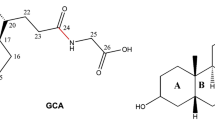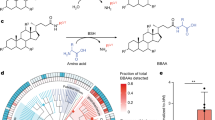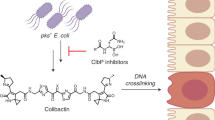Abstract
Bile salt hydrolase (BSH) enzymes are widely expressed by human gut bacteria and catalyze the gateway reaction leading to secondary bile acid formation. Bile acids regulate key metabolic and immune processes by binding to host receptors. There is an unmet need for a potent tool to inhibit BSHs across all gut bacteria to study the effects of bile acids on host physiology. Here, we report the development of a covalent pan-inhibitor of gut bacterial BSHs. From a rationally designed candidate library, we identified a lead compound bearing an alpha-fluoromethyl ketone warhead that modifies BSH at the catalytic cysteine residue. This inhibitor abolished BSH activity in conventional mouse feces. Mice gavaged with a single dose of this compound displayed decreased BSH activity and decreased deconjugated bile acid levels in feces. Our studies demonstrate the potential of a covalent BSH inhibitor to modulate bile acid composition in vivo.
This is a preview of subscription content, access via your institution
Access options
Access Nature and 54 other Nature Portfolio journals
Get Nature+, our best-value online-access subscription
$29.99 / 30 days
cancel any time
Subscribe to this journal
Receive 12 print issues and online access
$259.00 per year
only $21.58 per issue
Buy this article
- Purchase on Springer Link
- Instant access to full article PDF
Prices may be subject to local taxes which are calculated during checkout





Similar content being viewed by others
Data availability
The 16S rDNA datasets analyzed in the manuscript are available through the NCBI under accession number PRJNA574158. The coordinates for both the apo and covalently inhibited forms of the BSH are deposited in the PDB and have PDB ID codes 6UFY and 6UH4, respectively. Raw mass spectrometry data were deposited at MassIVE (massive.ucsd.edu). Native mass spectrometry data files are available for download from the MassIVE archive at the University of California, San Diego (ftp://massive.ucsd.edu/MSV000084491/). All other data generated or analyzed during this study are included in this article and its Supplementary Information files.
Code availability
No custom code or mathematical algorithms were used in this study.
References
Ridlon, J. M., Kang, D.-J. & Hylemon, P. B. Bile salt biotransformations by human intestinal bacteria. J. Lipid Res. 47, 241–259 (2006).
Fiorucci, S. & Distrutti, E. Bile acid-activated receptors, intestinal microbiota, and the treatment of metabolic disorders. Trends Mol. Med. 21, 702–714 (2015).
Setchell, K. D., Lawson, A. M., Tanida, N. & Sjövall, J. General methods for the analysis of metabolic profiles of bile acids and related compounds in feces. J. Lipid Res. 24, 1085–1100 (1983).
Hamilton, J. P. et al. Human cecal bile acids: concentration and spectrum. Am. J. Physiol. Gastrointest. Liver Physiol. 293, G256–G263 (2007).
Modica, S., Gadaleta, R. M. & Moschetta, A. Deciphering the nuclear bile acid receptor FXR paradigm. Nucl. Recept Signal 8, e005 (2010).
Vavassori, P., Mencarelli, A., Renga, B., Distrutti, E. & Fiorucci, S. The bile acid receptor FXR is a modulator of intestinal innate immunity. J. Immunol. 183, 6251–6261 (2009).
Pols, T. W. H. et al. Lithocholic acid controls adaptive immune responses by inhibition of Th1 activation through the Vitamin D receptor. PLoS One 12, e0176715 (2017).
Begley, M., Hill, C. & Gahan, C. G. M. Bile salt hydrolase activity in probiotics. Appl. Environ. Microbiol. 72, 1729–1738 (2006).
Chiang, J. Y. Recent advances in understanding bile acid homeostasis. F1000Res 6, 2029 (2017).
Song, Z. et al. Taxonomic profiling and populational patterns of bacterial bile salt hydrolase (BSH) genes based on worldwide human gut microbiome. Microbiome 7, 9 (2019).
Strelow, J. M. A perspective on the kinetics of covalent and irreversible inhibition. SLAS Disco. 22, 3–20 (2017).
Roberts, A. B. et al. Development of a gut microbe-targeted nonlethal therapeutic to inhibit thrombosis potential. Nat. Med. 24, 1407–1417 (2018).
Rossocha, M. et al. Conjugated bile acid hydrolase is a tetrameric N-terminal thiol hydrolase with specific recognition of its cholyl but not of its tauryl product. Biochem. 44, 5739–5748 (2005).
Huijghebaert, S. M. & Hofmann, A. F. Influence of the amino acid moiety on deconjugation of bile acid amidates by cholylglycine hydrolase or human fecal cultures. J. Lipid Res. 27, 742–752 (1986).
Kawamoto, K., Horibe, I. & Uchida, K. Purification and characterization of a new hydrolase for conjugated bile acids, chenodeoxycholyltaurine hydrolase, from Bacteroides vulgatus. J. Biochem. 106, 1049–1053 (1989).
Yao, L. et al. A selective gut bacterial bile salt hydrolase alters host metabolism. eLife 7, 675 (2018).
Liu, Q. et al. Developing irreversible inhibitors of the protein kinase cysteinome. Chem. Biol. 20, 146–159 (2013).
Wilson, A. J., Kerns, J. K., Callahan, J. F. & Moody, C. J. Keap calm, and carry on covalently. J. Medicinal Chem. 56, 7463–7476 (2013).
Serafimova, I. M. et al. Reversible targeting of noncatalytic cysteines with chemically tuned electrophiles. Nat. Chem. Biol. 8, 471–476 (2012).
Henise, J. C. & Taunton, J. Irreversible Nek2 kinase inhibitors with cellular activity. J. Med. Chem. 54, 4133–4146 (2011).
Xie, T. et al. Pharmacological targeting of the pseudokinase Her3. Nat. Chem. Biol. 10, 1006–1012 (2014).
Quintás-Cardama, A., Kantarjian, H., Cortes, J. & Verstovsek, S. Janus kinase inhibitors for the treatment of myeloproliferative neoplasias and beyond. Nat. Rev. Drug Discov. 10, 127–140 (2011).
Cohen, M. S., Zhang, C., Shokat, K. M. & Taunton, J. Structural bioinformatics-based design of selective, irreversible kinase inhibitors. Science 308, 1318–1321 (2005).
Angliker, H., Wikstrom, P., Rauber, P. & Shaw, E. The synthesis of lysylfluoromethanes and their properties as inhibitors of trypsin, plasmin and cathepsin B. Biochem. J. 241, 871–875 (1987).
Miller, R. M. & Taunton, J. Targeting protein kinases with selective and semipromiscuous covalent inhibitors. Meth. Enzymol. 548, 93–116 (2014).
Coleman, J. P. & Hudson, L. L. Cloning and characterization of a conjugated bile acid hydrolase gene from Clostridium perfringens. Appl. Environ. Microbiol. 61, 2514–2520 (1995).
Tanaka, H., Hashiba, H., Kok, J. & Mierau, I. Bile salt hydrolase of Bifidobacterium longum-biochemical and genetic characterization. Appl. Environ. Microbiol. 66, 2502–2512 (2000).
Wang, Z. et al. Identification and characterization of a bile salt hydrolase from Lactobacillus salivarius for development of novel alternatives to antibiotic growth promoters. Appl. Environ. Microbiol. 78, 8795–8802 (2012).
Stellwag, E. J. & Hylemon, P. B. Purification and characterization of bile salt hydrolase from Bacteroides fragilis subsp. fragilis. Biochimica et. Biophysica Acta–Enzymol. 452, 165–176 (1976).
Smith, K., Zeng, X. & Lin, J. Discovery of bile salt hydrolase inhibitors using an efficient high-throughput screening system. PLoS One 9, e85344 (2014).
Sayin, S. I. et al. Gut microbiota regulates bile acid metabolism by reducing the levels of tauro-beta-muricholic acid, a naturally occurring FXR antagonist. Cell Metab. 17, 225–235 (2013).
Li, F. et al. Microbiome remodelling leads to inhibition of intestinal farnesoid X receptor signalling and decreased obesity. Nat. Commun. 4, 2384 (2013).
Hofmann, A. F. The function of bile salts in fat absorption. The solvent properties of dilute micellar solutions of conjugated bile acids. Biochem. J. 89, 57–68 (1963).
Ferruzza, S., Rossi, C., Scarino, M. L. & Sambuy, Y. A protocol for differentiation of human intestinal Caco-2 cells in asymmetric serum-containing medium. Toxicol. Vitr. 26, 1252–1255 (2012).
Lanning, B. R. et al. A road map to evaluate the proteome-wide selectivity of covalent kinase inhibitors. Nat. Chem. Biol. 10, 760–767 (2014).
Parasar, B. et al. Chemoproteomic profiling of gut microbiota-associated bile salt hydrolase activity. ACS Cent. Sci. 5, 867–873 (2019).
Alnouti, Y. Bile Acid sulfation: a pathway of bile acid elimination and detoxification. Toxicol. Sci. 108, 225–246 (2009).
Padmanabhan, P., Grosse, J., Asad, A. B. M. A., Radda, G. K. & Golay, X. Gastrointestinal transit measurements in mice with 99mTc-DTPA-labeled activated charcoal using NanoSPECT-CT. EJNMMI Res. 3, 60–68 (2013).
Singh, J., Petter, R. C., Baillie, T. A. & Whitty, A. The resurgence of covalent drugs. Nat. Rev. Drug Discov. 10, 307–317 (2011).
Turk, B. Targeting proteases: successes, failures and future prospects. Nat. Rev. Drug Discov. 5, 785–799 (2006).
Johnson, D. S., Weerapana, E. & Cravatt, B. F. Strategies for discovering and derisking covalent, irreversible enzyme inhibitors. Future Med. Chem. 2, 949–964 (2010).
Joyce, S. A. et al. Regulation of host weight gain and lipid metabolism by bacterial bile acid modification in the gut. Proc. Natl Acad. Sci. USA 111, 7421–7426 (2014).
Ma, C. et al. Gut microbiome-mediated bile acid metabolism regulates liver cancer via NKT cells. Science 360, eaan5931 (2018).
Wallace, B. D. et al. Alleviating cancer drug toxicity by inhibiting a bacterial enzyme. Science 330, 831–835 (2010).
Xie, C. et al. An intestinal farnesoid X receptor-ceramide signaling axis modulates hepatic gluconeogenesis in mice. Diabetes 66, 613–626 (2017).
McCoy, A. J. et al. Phaser crystallographic software. J. Appl. Crystallogr. 40, 658–674 (2007).
Afonine, P. V. et al. Towards automated crystallographic structure refinement with phenix.refine. Acta Crystallogr. D. 68, 352–367 (2012).
Chen, V. B. et al. MolProbity: all-atom structure validation for macromolecular crystallography. Acta Crystallogr. D. 66, 12–21 (2010).
Morin, A. et al. Collaboration gets the most out of software. eLife 2, e01456 (2013).
Ficarro, S. B., Alexander, W. M. & Marto, J. A. mzStudio: a dynamic digital canvas for user-driven interrogation of mass spectrometry data. Proteomes 5, 20 (2017).
Verhoeckx, K. et al. Caco-2 Cell Line. Impact Food Bioact. Health 175, 103–111 (2015).
Weerapana, E., Speers, A. E. & Cravatt, B. F. Tandem orthogonal proteolysis-activity-based protein profiling (TOP-ABPP)–a general method for mapping sites of probe modification in proteomes. Nat. Protoc. 2, 1414–1425 (2007).
Ficarro, S. B. et al. Improved electrospray ionization efficiency compensates for diminished chromatographic resolution and enables proteomics analysis of tyrosine signaling in embryonic stem cells. Anal. Chem. 81, 3440–3447 (2009).
Alexander, W. M., Ficarro, S. B., Adelmant, G. & Marto, J. A. multiplierz v2.0: a Python-based ecosystem for shared access and analysis of native mass spectrometry data. Proteomics 17, 1700091 (2017).
Zybailov, B. et al. Statistical analysis of membrane proteome expression changes in Saccharomyces cerevisiae. J. Proteome Res. 5, 2339–2347 (2006).
Callahan, B. J. et al. DADA2: High-resolution sample inference from Illumina amplicon data. Nat. Methods 13, 581–583 (2016).
Caporaso, J. G. et al. QIIME allows analysis of high-throughput community sequencing data. Nat. Methods 7, 335–336 (2010).
Schloss, P. D. et al. Introducing mothur: open-source, platform-independent, community-supported software for describing and comparing microbial communities. Appl. Environ. Microbiol. 75, 7537–7541 (2009).
Weber, N. et al. Nephele: a cloud platform for simplified, standardized and reproducible microbiome data analysis. Bioinformatics 34, 1411–1413 (2018).
Wrzosek, L. et al. Transplantation of human microbiota into conventional mice durably reshapes the gut microbiota. Sci. Rep. 8, 6854–6859 (2018).
Acknowledgements
This research was supported National Institutes of Health (NIH) grant nos. R35 GM128618 (to A.S.D.), R35 CA220340 (to S.C.B.), R01 CA222218 (to J.A.M.), an Innovation Award from the Center for Microbiome Informatics and Therapeutics at MIT (to A.S.D.), a grant from Harvard Digestive Diseases Center (supported by NIH grant no. 5P30DK034854-32 to A.S.D.), a Karin Grunebaum Cancer Research Foundation Faculty Research Fellowship (to A.S.D.), a John and Virginia Kaneb Fellowship (to A.S.D.), a Quadrangle Fund for the Advancement and Seeding of Translational Research at Harvard Medical School (Q-FASTR) grant (to A.S.D.) and an HMS Dean’s Innovation Grant in the Basic and Social Sciences (to A.S.D.). L.Y. and S.N.C. acknowledge a Wellington Postdoctoral Fellowship and an American Heart Association Postdoctoral Fellowship, respectively. M.D.M. acknowledges an NSF Graduate Research Fellowship (no. DGE1745303). D.R. is supported by the Early postdoc mobility fellowship from the Swiss National Science Foundation. We thank N. Gray, D. Scott, J. M. Hatcher, J. Wang, J. Clardy, M. Henke and members of the Clardy group for helpful discussions. We thank the ICCB-Longwood Screening Facility for use of their fluorescent plate reader.
Author information
Authors and Affiliations
Contributions
A.A.A. and A.S.D. conceived the project and designed the experiments. A.A.A. performed most of the experiments. T.C.M.S. and S.C.B. performed the crystallization studies. S.B.F. and J.A.M. performed the mass spectrometry studies. D.R. and A.S.B. performed the in vivo experiments and provided fresh mouse feces. M.D.M. purified and performed experiments with B. longum BSH and performed kinetic studies with B. theta BSH. L.Y. performed the in vitro FXR assays and provided help with experiments. S.N.C. performed the cell culture assays. S.N.F. assisted with bacterial culture experiments. A.A.A. and A.S.D. wrote the manuscript. All authors edited and contributed to the critical review of the manuscript.
Corresponding author
Ethics declarations
Competing interests
A.S.D. is an ad hoc consultant for Kintai Therapeutics and HP Hood. S.C.B. serves on the SAB for Erasca, Inc., is a consultant on unrelated projects for Ayala Pharmaceutical and IFM Therapeutics and receives funding from Novartis for an unrelated project. J.A.M. serves on the SAB of 908 Devices (Boston, MA). The other authors declare that no competing interests exist.
Additional information
Publisher’s note Springer Nature remains neutral with regard to jurisdictional claims in published maps and institutional affiliations.
Supplementary information
Supplementary Information
Supplementary Tables 1–10, Figs. 1–18 and Synthetic Procedures
Rights and permissions
About this article
Cite this article
Adhikari, A.A., Seegar, T.C.M., Ficarro, S.B. et al. Development of a covalent inhibitor of gut bacterial bile salt hydrolases. Nat Chem Biol 16, 318–326 (2020). https://doi.org/10.1038/s41589-020-0467-3
Received:
Accepted:
Published:
Issue Date:
DOI: https://doi.org/10.1038/s41589-020-0467-3
This article is cited by
-
The changing metabolic landscape of bile acids – keys to metabolism and immune regulation
Nature Reviews Gastroenterology & Hepatology (2024)
-
Another renaissance for bile acid gastrointestinal microbiology
Nature Reviews Gastroenterology & Hepatology (2024)
-
Bile salt hydrolase catalyses formation of amine-conjugated bile acids
Nature (2024)
-
Gut microbiota-bile acid crosstalk regulates murine lipid metabolism via the intestinal FXR-FGF19 axis in diet-induced humanized dyslipidemia
Microbiome (2023)
-
Bile salt hydrolase in non-enterotoxigenic Bacteroides potentiates colorectal cancer
Nature Communications (2023)



